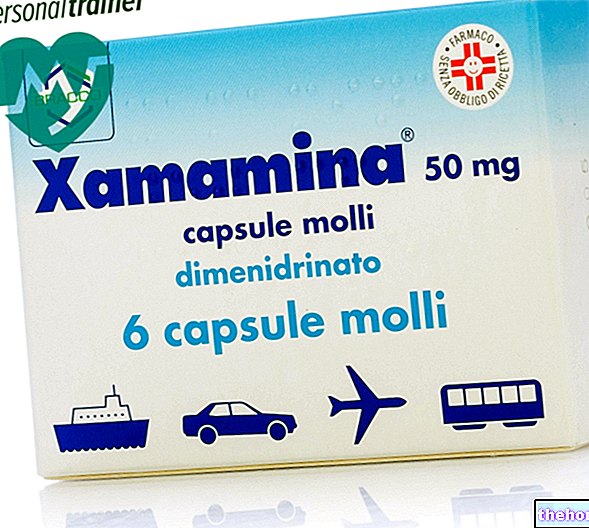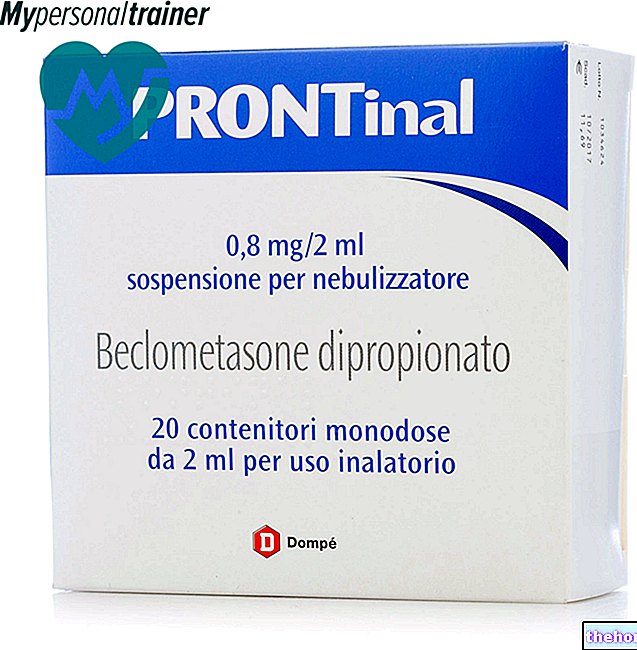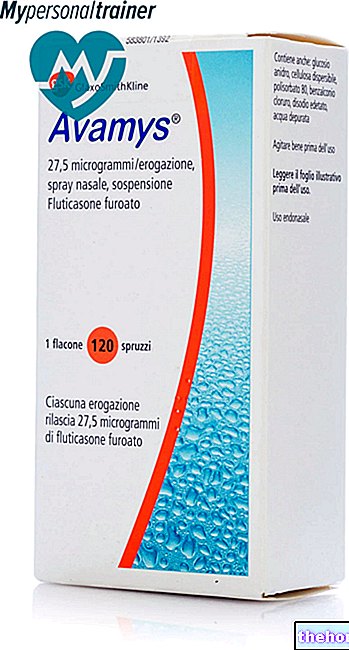Active ingredients: Loperamide
DISSENTEN 2 mg tablets
Why is Dissenten used? What is it for?
PHARMACOTHERAPEUTIC CATEGORY
Antidiarrheal drug.
THERAPEUTIC INDICATIONS
DISSENTEN is indicated for the symptomatic treatment of acute diarrhea and exacerbations of chronic diarrhea.
Contraindications When Dissenten should not be used
Hypersensitivity to the active substance or to any of the excipients. DISSENTEN is contraindicated in children under 6 years of age. DISSENTEN should not be used as primary therapy:
- in patients with acute dysentery, characterized by blood in the stool and high fever
- in patients with acute ulcerative colitis
- in patients with pseudomembranous colitis associated with the use of broad spectrum antibiotics
- in patients with bacterial enterocolitis caused by invasive organisms including Salmonella, Shigella and Campilobacter.
In general, the use of DISSENTEN is contraindicated in all cases where inhibition of peristalsis must be avoided due to the possible risk of significant consequences such as ileus, megacolon and toxic megacolon. treatment.
Precautions for use What you need to know before you take Dissenten
Treatment of diarrhea with DISSENTEN is symptomatic only; therefore, where possible, it is also advisable to intervene on the causes of the disturbance.
Diarrhea, especially in children, can lead to a loss of fluids and salts. In these cases the most important countermeasure is the administration of an "adequate replacement therapy based on fluids and electrolytes.
Treatment with DISSENTEN should be discontinued if no improvement in clinical symptoms occurs within 48 hours after initiation of therapy and the patient should consult their physician.
AIDS patients treated with DISSENTEN for diarrhea should discontinue therapy at the first signs of abdominal distension and consult their physician. In these patients with infectious colitis of bacterial or viral origin, treated with loperamide hydrochloride, there have been isolated cases of constipation with an increased risk of toxic megacolon.
Patients with liver problems should inform their doctor before taking DISSENTEN. Loperamide is subject to an intense first pass metabolism. Although no pharmacokinetic data are available in patients with hepatic impairment, loperamide hydrochloride should be used with caution in these patients due to impaired first pass metabolism. Therefore, patients with hepatic dysfunction should be carefully monitored for signs of central nervous system (CNS) toxicity.
Interactions Which drugs or foods can modify the effect of Dissenten
Tell your doctor or pharmacist if you have recently taken any other medicines, even those without a prescription.
Non-clinical data demonstrated that loperamide is a substrate of P-glycoprotein. Concomitant administration of loperamide (single 16 mg dose) with quinidine or ritonavir, both of which are inhibitors of P-glycoprotein, resulted in a 2 to 3-fold increase in plasma levels of loperamide. The clinical relevance of this pharmacokinetic interaction with P-glycoprotein inhibitors when loperamide is administered at recommended doses is unknown.
Concomitant administration of loperamide (single 4 mg dose) and itraconazole, an inhibitor of CYP3A4 and P-glycoprotein, resulted in a 3 to 4-fold increase in loperamide plasma concentrations. In the same study, gemfibrozil, a CYP2C8 inhibitor, increased plasma concentrations of loperamide approximately 2-fold. The combination of itraconazole and gemfibrozil showed a 4-fold increase in peak plasma levels of loperamide and a 13-fold increase in total plasma exposure. These increases were not associated with central nervous system (CNS) effects, such as detected by psychomotor tests (e.g. subjective sleepiness and the DigitSymbolSubstitution Test).
Concomitant administration of loperamide (single dose of 16 mg) and ketoconazole, an inhibitor of CYP3A4 and P-glycoprotein, resulted in a 5-fold increase in plasma concentrations of loperamide. This increase was not associated with an increase in pharmacodynamic effects, as detected by pupillometry.
Concomitant treatment with oral desmopressin resulted in a 3-fold increase in plasma concentrations of desmopressin, presumably due to a slowing of gastrointestinal motility.
Treatment with substances with similar pharmacological properties can enhance the effect of loperamide and drugs that accelerate intestinal transit can diminish its effect.
The concomitant use of CYP450 inhibitors is not recommended.
Warnings It is important to know that:
Pregnancy and breastfeeding
Ask your doctor or pharmacist for advice before taking any medicine.
Although there is no indication that loperamide hydrochloride possesses teratogenic or embryotoxic properties, the anticipated therapeutic benefits must be weighed against the potential risks before administering loperamide hydrochloride during pregnancy, especially during the first trimester.
Small amounts of loperamide can appear in human breast milk. Therefore loperamide hydrochloride is not recommended during breastfeeding.
Effects on ability to drive and use machines
DISSENTEN can cause tiredness, dizziness or sleepiness. Therefore caution is advised when driving a vehicle or operating machinery.
Dosage and method of use How to use Dissenten: Dosage
The tablets should be taken with some liquid.
Adults and children between the ages of 6 and 17
The starting dose is 2 tablets (4 mg) for adults and 1 tablet (2 mg) for children; thereafter 1 tablet (2 mg) after each subsequent evacuation of unformed (soft) faeces.
The maximum daily dose for adults is 8 tablets (16 mg). For children, the dose should be related to body weight (3 tablets / 20 kg) but should not exceed a maximum of 8 tablets per day.
Decrease the dose when the stool is normalized and stop treatment in case of constipation. Warning: do not use for more than two days.
Children under 6 years of age
DISSENTEN should not be used in children under 6 years of age.
Senior citizens
No dose adjustment is necessary in the elderly.
Renal dysfunction
No dose adjustment is required in patients with renal dysfunction.
Hepatic dysfunction
DISSENTEN should be used with caution in these patients due to impaired first pass metabolism (see "Precautions for use").
Overdose What to do if you have taken too much Dissenten
Symptoms
CNS depression (stupor, coordination abnormalities, somnolence, miosis, muscle hypertonia, respiratory depression), urinary retention and ileus may occur in overdose, including that caused by hepatic dysfunction.
Children may be more sensitive than adults to the effects of a loperamide overdose. Therefore it is recommended to keep the product out of their reach because accidental ingestion, especially in children under 4 years old, can cause constipation and central nervous system depression with drowsiness and slowed breathing. In this case the child must be kept under careful observation for 48 hours.
Treatment
Measures in case of overdose: gastric lavage, induction of vomiting, enema or administration of laxatives.
If symptoms of overdose occur, naloxone can be given as an antidote. Since the duration of action of loperamide is longer than that of naloxone (1 to 3 hours), repeated treatment with naloxone may be indicated. Therefore the patient should be monitored closely. for at least 48 hours to highlight any worsening of the central nervous system depression.
In case of accidental intake of an excessive dose of DISSENTEN, notify your doctor immediately or go to the nearest hospital.
IF YOU HAVE ANY DOUBTS ABOUT THE USE OF DISSENTEN, CONTACT YOUR DOCTOR OR PHARMACIST.
Side Effects What are the side effects of Dissenten
Like all medicines, DISSENTEN can cause side effects, although not everybody gets them.
Adults and children aged 12 years and over
The safety of loperamide hydrochloride was evaluated in 3076 adults and children aged ≥12 years who participated in 31 controlled and uncontrolled clinical trials with loperamide hydrochloride used for the treatment of diarrhea. Of these, 26 studies were on acute diarrhea (N = 2755) and 5 on chronic diarrhea (N = 321).
The most commonly reported adverse drug reactions (ADRs) (ie with an "incidence ≥1%) in clinical trials with loperamide hydrochloride for the treatment of acute diarrhea were: constipation (2.7%), flatulence ( 1.7%), headache (1.2%) and nausea (1.1%). In clinical trials for the treatment of chronic diarrhea the most commonly reported ADRs (i.e. with an "incidence ≥1%) were : flatulence (2.8%), constipation (2.2%), nausea (1.2%) and dizziness (1.2%).
Table 1 presents the results of 3076 adult and child subjects ≥12 years of age who participated in 31 controlled and uncontrolled clinical trials with loperamide hydrochloride used for the treatment of diarrhea. Of these, 26 studies were acute diarrhea (N = 2755) and 5 were chronic diarrhea (N = 321). The frequency categories presented in Table 1 use the following convention: very common (≥1 / 10), common (≥1 / 100,
Table 1 Frequency of adverse reactions reported with the use of loperamide hydrochloride from clinical studies in adults and children aged ≥12 years
a The inclusion of this term is based on post-marketing reporting for loperamide hydrochloride. Since the post-marketing ADR determination process did not differentiate between indications of chronic and acute diarrhea or between adults and children, the frequency is estimated based on all clinical studies with loperamide hydrochloride combined, including those in children aged ≤12 years (N = 3683).
b See section 4.4, Special Warnings and Precautions for Use.
c Reported only with orodispersible tablets.
For adverse reactions observed during clinical trials and with no indication of frequency, the term was not observed or was not considered an adverse reaction for this indication.
Pediatric population
The safety of loperamide hydrochloride was evaluated in 607 patients aged 10 days to 13 years who participated in 13 controlled and uncontrolled clinical trials with loperamide hydrochloride used for the treatment of acute diarrhea. In general, the profile of ADRs in this patient population was similar to that observed in clinical trials with loperamide hydrochloride in adults and children aged 12 years and older.
Compliance with the instructions contained in the package leaflet reduces the risk of undesirable effects.
Reporting of side effects
If you get any side effects, talk to your doctor or pharmacist. This includes any possible side effects not listed in this leaflet. Side effects can also be reported directly via the national reporting system at https://www.aifa.gov.it/content/segnalazioni-reazioni-avverse. By reporting side effects you can help provide more information on safety of this medicine.
Expiry and Retention
Expiry: see the expiry date printed on the package.
The expiry date refers to the product in intact packaging, correctly stored.
WARNING: Do not use the medicine after the expiry date stated on the package. Medicines should not be disposed of via wastewater or household waste. Ask your pharmacist how to throw away medicines you no longer use. This will help protect the environment. .
Keep this medicine out of the reach and sight and reach of children.
Composition and pharmaceutical form
COMPOSITION
Each tablet contains:
Active principle:
Loperamide hydrochloride
Excipients:
magnesium stearate, microgranular cellulose.
PHARMACEUTICAL FORM AND CONTENT
Tablets.
Box of 30 tablets of 2 mg.
Box of 15 tablets of 2 mg. 2 mg
Source Package Leaflet: AIFA (Italian Medicines Agency). Content published in January 2016. The information present may not be up-to-date.
To have access to the most up-to-date version, it is advisable to access the AIFA (Italian Medicines Agency) website. Disclaimer and useful information.
01.0 NAME OF THE MEDICINAL PRODUCT
DISSENTEN 2 MG TABLETS
02.0 QUALITATIVE AND QUANTITATIVE COMPOSITION
Each tablet contains:
Active principle:
Loperamide hydrochloride 2 mg
For the full list of excipients, see section 6.1.
03.0 PHARMACEUTICAL FORM
Tablets.
04.0 CLINICAL INFORMATION
04.1 Therapeutic indications
Dissenten is indicated for the symptomatic treatment of acute diarrhea and exacerbations of chronic diarrhea.
04.2 Posology and method of administration
The tablets should be taken with some liquid.
Adults and children between the ages of 6 and 17
The starting dose is 2 tablets (4 mg) for adults and 1 tablet (2 mg) for children; thereafter 1 tablet (2 mg) after each subsequent evacuation of unformed (soft) faeces.
The maximum daily dose for adults is 8 tablets (16 mg). For children, the dose should be related to body weight (3 tablets / 20 kg) but should not exceed a maximum of 8 tablets per day.
Decrease the dose when the stool is normalized and stop treatment in case of constipation.
Warning: do not use for more than two days.
Children under 6 years of age
Dissenten should not be used in children under 6 years of age.
Senior citizens
No dose adjustment is necessary in the elderly.
Kidney damage
No dose adjustment is necessary in patients with renal impairment.
Hepatic impairment
Although no pharmacokinetic data are available in patients with hepatic impairment, DISSENTEN should be used with caution in these patients due to impaired first pass metabolism (see section 4.4 "Special warnings and precautions for use").
04.3 Contraindications
Hypersensitivity to the active substance or to any of the excipients.
DISSENTEN is contraindicated in children under 6 years of age.
DISSENTEN should not be used as primary therapy:
• in patients with acute dysentery characterized by blood in the stool and high fever
• in patients with acute ulcerative colitis
• in patients with pseudomembranous colitis associated with the use of broad spectrum antibiotics
• in patients with bacterial enterocolitis caused by invasive organisms including Salmonella, Shigella and Campilobacter.
In general, the use of DISSENTEN is contraindicated in all cases where inhibition of peristalsis must be avoided due to the possible risk of significant consequences such as ileus, megacolon and toxic megacolon. Should constipation, abdominal distension or ileus occur, stop immediately the treatment.
04.4 Special warnings and appropriate precautions for use
Treatment of diarrhea with loperamide hydrochloride is symptomatic only. Whenever an "underlying etiology can be determined, specific treatment should be given when appropriate.
Fluid and electrolyte depletion may occur in patients with diarrhea, especially children. In these cases the most important countermeasure is the administration of an "adequate replacement therapy based on fluids and electrolytes.
Treatment with DISSENTEN should be discontinued if no improvement in clinical symptoms occurs within 48 hours after initiation of therapy and the patient should consult their physician.
AIDS patients treated with DISSENTEN for diarrhea should discontinue therapy at the first signs of abdominal distension. In these patients with infectious colitis of bacterial or viral origin, treated with loperamide hydrochloride, there have been isolated cases of constipation with an increased risk of toxic megacolon.
Loperamide hydrochloride is subject to intense first pass metabolism. Although no pharmacokinetic data are available in patients with hepatic impairment, loperamide hydrochloride should be used with caution in these patients due to impaired first pass metabolism. Therefore, patients with hepatic impairment should be carefully monitored for signs of central nervous system (CNS) toxicity.
04.5 Interactions with other medicinal products and other forms of interaction
Non-clinical data demonstrated that loperamide is a substrate of P-glycoprotein. Concomitant administration of loperamide (single 16 mg dose) with quinidine or ritonavir, both of which are inhibitors of P-glycoprotein, resulted in a 2 to 3-fold increase in plasma levels of loperamide. The clinical relevance of this pharmacokinetic interaction with P-glycoprotein inhibitors when loperamide is administered at recommended doses is unknown.
Concomitant administration of loperamide (single 4 mg dose) and itraconazole, an inhibitor of CYP3A4 and P-glycoprotein, resulted in a 3 to 4-fold increase in loperamide plasma concentrations. In the same study, gemfibrozil, a CYP2C8 inhibitor, increased plasma concentrations of loperamide approximately 2-fold. The combination of itraconazole and gemfibrozil showed a 4-fold increase in peak plasma levels of loperamide and a 13-fold increase in total plasma exposure. These increases were not associated with central nervous system (CNS) effects, such as detected by psychomotor tests (e.g. subjective sleepiness and the Digit Symbol Substitution Test).
Concomitant administration of loperamide (single dose of 16 mg) and ketoconazole, an inhibitor of CYP3A4 and P-glycoprotein, resulted in a 5-fold increase in plasma concentrations of loperamide. This increase was not associated with an increase in pharmacodynamic effects, as detected by pupillometry.
Concomitant treatment with oral desmopressin resulted in a 3-fold increase in plasma concentrations of desmopressin, presumably due to a slowing of gastrointestinal motility.
Treatment with substances with similar pharmacological properties can enhance the effect of loperamide and drugs that accelerate intestinal transit can diminish its effect.
The concomitant use of CYP 450 inhibitors is not recommended.
04.6 Pregnancy and lactation
Although there is no indication that loperamide hydrochloride possesses teratogenic or embryotoxic properties, the anticipated therapeutic benefits must be weighed against the potential risks before administering loperamide hydrochloride during pregnancy, especially during the first trimester.
Small amounts of loperamide can appear in human breast milk. Therefore loperamide hydrochloride is not recommended during breastfeeding.
04.7 Effects on ability to drive and use machines
Fatigue, dizziness or somnolence may occur in the context of diarrheal syndromes treated with loperamide hydrochloride. Therefore caution is advised when driving a vehicle or operating machinery.
04.8 Undesirable effects
Adults and children aged ≥12 years
The safety of loperamide hydrochloride was evaluated in 3076 adults and children aged ≥12 years who participated in 31 controlled and uncontrolled clinical trials with loperamide hydrochloride used for the treatment of diarrhea. Of these, 26 studies were on acute diarrhea (N = 2755) and 5 on chronic diarrhea (N = 321).
The most commonly reported adverse drug reactions (ADRs) (ie with an "incidence ≥1%) in clinical trials with loperamide hydrochloride for the treatment of acute diarrhea were: constipation (2.7%), flatulence ( 1.7%), headache (1.2%) and nausea (1.1%). In clinical trials for the treatment of chronic diarrhea the most commonly reported ADRs (i.e. with an "incidence ≥1%) were : flatulence (2.8%), constipation (2.2%), nausea (1.2%) and dizziness (1.2%).
Table 1 lists the ADRs that have been reported following the use of loperamide hydrochloride both in clinical trials (in acute or chronic diarrhea or both) and in post-marketing experience.
Conventionally, the frequency of undesirable effects is divided into the following categories: very common (≥1 / 10), common (≥1 / 100,
Table 1 Adverse drug reactions
a The inclusion of this term is based on post-marketing reporting for loperamide hydrochloride. Since the post-marketing ADR determination process did not differentiate between indications of chronic and acute diarrhea or between adults and children, the frequency is estimated based on all clinical studies with loperamide hydrochloride combined, including those in children aged ≤12 years (N = 3683).
b See section 4.4, Special Warnings and Precautions for Use.
c Reported only with orodispersible tablets.
For adverse reactions observed during clinical trials and with no indication of frequency, the term was not observed or was not considered an adverse reaction for this indication.
Pediatric population
The safety of loperamide hydrochloride was evaluated in 607 patients aged 10 days to 13 years who participated in 13 controlled and uncontrolled clinical trials with loperamide hydrochloride used for the treatment of acute diarrhea. In general, the profile of ADRs in this patient population was similar to that observed in clinical trials with loperamide hydrochloride in adults and children aged 12 years and older.
Reporting of suspected adverse reactions.
Reporting of suspected adverse reactions occurring after authorization of the medicinal product is important as it allows continuous monitoring of the benefit / risk balance of the medicinal product. Healthcare professionals are asked to report any suspected adverse reactions via the national reporting system. "address www.agenziafarmaco.gov.it/it/responsabili.
04.9 Overdose
Symptoms
In the event of overdose, including that caused by hepatic dysfunction, CNS depression (stupor, coordination abnormalities, somnolence, miosis, muscle hypertonia, respiratory depression), urinary retention and ileus may occur.
Children may be more sensitive than adults to the effects of a loperamide overdose. Therefore it is recommended to keep the product out of their reach because accidental ingestion, especially in children under 4 years old, can cause constipation and central nervous system depression with drowsiness and slowed breathing. In this case the child must be kept under careful observation for 48 hours.
Treatment
Measures in case of overdose: gastric lavage, induction of vomiting, enema or administration of laxatives.
If symptoms of overdose develop, naloxone can be given as an antidote. Since the duration of action of loperamide is longer than that of naloxone (1 to 3 hours), repeated treatment with naloxone may be indicated. Therefore the patient should be monitored closely for at least 48 hours for any aggravation of depression. of the central nervous system.
05.0 PHARMACOLOGICAL PROPERTIES
05.1 Pharmacodynamic properties
Pharmacotherapeutic group: antipropulsants, ATC code: A07DA03.
Loperamide is a synthetic substance with an antidiarrheal effect, which can be used orally. It acts by selectively slowing intestinal motility, through a "direct action on the longitudinal and circular smooth muscles of the intestinal wall, interacting with both cholinergic and non-cholinergic intrinsic vegetative neurons. Experimental research on isolated organs has in fact shown that loperamide causes a dose-dependent reduction of the peristaltic activity at the ileal level and is able to inhibit the spasmogenic effects induced by electrical stimulation or by the administration of nicotine and prostaglandins. Other pharmacological studies have shown that the substance is more potent than diphenoxylate, morphine or codeine in slowing the gastrointestinal progression of a bolus of coal in mice and in reducing diarrhea from castor oil administration in mice and rats. At therapeutic doses, loperamide is devoid of opioid-like effects in humans.
05.2 Pharmacokinetic properties
After oral administration in humans, peak blood levels are observed within 4 hours with a half-life between 7 and 15 hours. Most (25%) is excreted with the faeces in unchanged form within 3 days, while in the urine in this period is found 1-2% as free drug or conjugated with glucuronic acid.
05.3 Preclinical safety data
From a toxicological point of view, the preparation is endowed with modest acute toxicity (LD50 per os = 185 mg / kg in the rat, 105 mg / kg in the mouse, 41.5 mg / kg in the guinea pig) and low chronic toxicity (rat and dog for os) and is devoid of teratogenic activity (rat and rabbit per os).
06.0 PHARMACEUTICAL INFORMATION
06.1 Excipients
Magnesium stearate; microgranular cellulose.
06.2 Incompatibility
There are no known chemical or physico-chemical incompatibilities.
06.3 Period of validity
5 years
06.4 Special precautions for storage
No special storage precautions.
06.5 Nature of the immediate packaging and contents of the package
Box containing blister packs in opaque PVC and aluminum;
pack of 30 tablets or 15 tablets.
06.6 Instructions for use and handling
None.
07.0 MARKETING AUTHORIZATION HOLDER
SPA - Antibiotic Products Company S.p.A. - Via Biella, 8 - 20143 MILAN.
08.0 MARKETING AUTHORIZATION NUMBER
DISSENTEN 2 mg 30 tablets AIC 023694021
DISSENTEN 2 mg 15 tablets AIC 023694058
09.0 DATE OF FIRST AUTHORIZATION OR RENEWAL OF THE AUTHORIZATION
DISSENTEN 2 mg tablets: decree 1a AIC 4/10/78
Renewal 1/6/2010
10.0 DATE OF REVISION OF THE TEXT
February 2014.























-nelle-carni-di-maiale.jpg)




